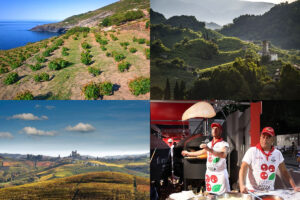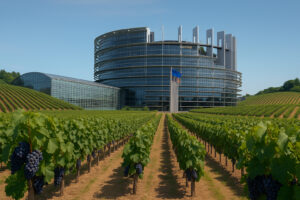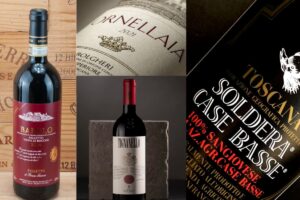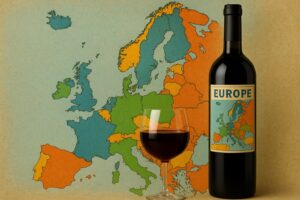The 2007 grape harvest has divided Italy in half: wine production in northern regions has remained similar to that of 2006 and quality is good. In the south, however, a notable decline in quantity, due to drought and virulent mildew attacks, has been registered. According to data from Ismea and the Italian Wine Union (UIV), Sicily has been particularly hard hit, registering an estimated decrease in production that will make this the smallest harvest over the past 30 years.
Overall, there is an expected decline of 12%, with total production reaching 43.5 million hectoliters. And, already by last July, it was obvious that this year’s harvest would also be, on average, 15-20 days earlier than usual.
”The prolonged absence of precipitation” – explained Ismea president, Arturo Semerari – “has strongly influenced the grape harvest; the anomalies in temperatures, which were decidedly above average in winter and spring, and a summer that brought its own problems for vineyards, are the cause of this situation in which the northern regions had an August spotted with rains, even storms, while, in the south, the climate continued to be hot and dry”.
”The current season” – added Andrea Sartori, UIV president) – has been characterized by an earliness already in its first phases, and, in August, where the climate was rather unstable in the north and did not favor high sugar levels in grapes, in the south, problems have resulted from the heat”.
The regional harvest data and predictions made by Ismea and the Italian Wine Union (UIV) are as follows:
In Piedmont, hailstorms affected Nebbiolo Barolo production areas; in the Veneto and Liguria losses were contained at 5% and quality is good; Valle d’Aosta should have production levels similar to that of 2006; in Trentino Alto Adige, harvesting began 20 days earlier than in 2006 but quality should be excellent; Friuli Venezia Giulia is the only area that has registered an increase in production over 2006 (5-10%); Emilia Romagna is registering a decrease of 10% due to drought; Tuscany is also expecting a 5-10% decrease in production because of the prolonged absence of rain; reduced harvest of 5-10% in Umbria; Lazio’s decrease could reach between 10-15%, just as in the Marche and Abruzzo regions, where drought conditions were persistent; Puglia and Campagnia are registering a decrease of 20% and 10-15% respectively; a sharp decline in Molise (20%), Basilicata (20%), and Calabria (15%) has also occurred; Sicily, however, has registered the most severe decrease of 30%; Sardinia’s results are the most stable with both quantity and quality expected to be very good.
Focus: Brunello 2007 Harvest
Italy’s most famous Italian red wine is respecting the normal harvest canons. For a year in which Italy has experienced early harvest throughout all of its regions, Brunello di Montalcino seems to be one of the few grapes that have followed a normal maturation process and have arrived right on time for the harvest. Thus, producers are optimistic about the 2007 harvest, hoping for great satisfaction in, above all, quality levels. The director of the Brunello Consortium, Stefano Campatelli declared: “the grapes are healthy, the berries are concentrated, with high sugar levels, because even with the very dry and hot winter, the rains at the end of May and beginning of June re-established the natural vegetative equilibrium of the grapevines”.
And president of the Brunello Consortium, Stefano Campatelli, explained: “It is the microclimate that makes the difference. Our territory can boast of, along with the excellent work of producers, a natural gift, which is what makes our wine unique”. For the 2007 grape harvest, the Brunello Consortium is predicting a slight quantitative decrease of between 5 and 10%. The average annual production of Brunello di Montalcino is 6.5 million bottles, of which 60% is destined for export. The United States is the top importing country taking 25% of the total, followed by Germany with 10%, and Switzerland with 7%. The Montalcino area earns over 140 million euros per year for its wine.
France’s 2007 Harvest
With predictions set at production level decreases of 7% for a total of 49.1 million hectoliters, France’s 2007 grape harvest could be the worst since 1987. Though estimates in June first predicted a decline of only 3% (for a total of 51.2 million hectoliters), on August 20th, Viniflhor changed estimates, predicting a decrease of over 7%, the worst registered over the past twenty years (if 1991 and 2003 are excluded – years that were compromised, respectively, by severe freezes and droughts). The cause, according to Viniflhor, of this decrease is the fault of summer weather conditions, with cool temperatures and cloudiness that reduced early vegetation and permitted virulent attacks of pathogens like downy mildew, especially in northern regions. The maturation process has been heterogeneous and slow, but predictions for quality do leave room for hope.
These elements, along with an extirpation plan that has reduced total vineyard numbers by 16,000 hectares, has thus reduced this year’s harvest results to 49.1 million hectoliters (7.3% less than in 2006 and 3.8 million hectoliters less than the average total over the past five years), of which 22.8 is Vqprd (3.8%), 17.8 is table wine (10.6%), and 8.5 million wines of Cognac and Armagnac production (9.5%).
Copyright © 2000/2025
Contatti: info@winenews.it
Seguici anche su Twitter: @WineNewsIt
Seguici anche su Facebook: @winenewsit
Questo articolo è tratto dall'archivio di WineNews - Tutti i diritti riservati - Copyright © 2000/2025








































































































































































































